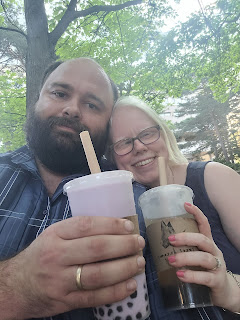About a year ago I gave my last update on the Victoria Park homeless encampment. At that time, the city had developed a new shelter option and was planning to renovate the island on which the residents were living. They had put up barricades around the two bridges connecting it to the rest of the park with guards protecting each entrance 24/7. They were admiting previous residents of the encampment but denied entry to newcomers.
A single woman held out long past everyone else. For months, she was guarded by two people around the clock and had sole rights to the island. She was a bit of a local celebrity. Eventually she did move out, and they've been working on the place over the summer to open it back to the public.
Last week we heard that the day had come and we went over to see how it looked. Nothing too different from before the encampment. There was the old gazebo, ornamental cannon, gardens... And then I saw this
For my job, during some of the partial lockdown measures in the pandemic, we hosted a park group. One day when I was facilitating, we saw the broken remains of an old tree. I reflected with the group on how much longer the tree had lived than any of us, how many things must have happened throughout its life, and how we were seeing the end of a very long story.
Well, this was that tree! I think it's a willow. It's been busy during the encampment and renovations! You can see where the thick stump stops abruptly, and it's now growing new branches and leaves.
Earlier this year, I read a book called The Hidden Life of Trees. Apparently trees communicate with each other through a fungal network attached to their roots, and they are able to transfer each other nutrients. They will do this even at the cost of their own resources in order to maintain a canopy, which is vital for the ecosystem. They will share with weaker trees and rivals. Sometimes they will even give nutrients to the bodies of passed relatives, with seemingly no other motivation than sentimentality.
Apparently trees are social creatures, and city-grown ones suffer from social isolation. They often never learn to talk or trade. I would assume this to be the case for the park's trees, but as we see here, this one is making a comeback despite the fact it was rendered completely defenseless. It's neighbours must have intervened!
Obviously this tree isn't forming a canopy with anyone. Willows are considered pioneering species, moving far away from their parents. Usually they're relatively solitary. Yet, this one still shares a root system and it must have been talking to its peers.
While we were taking pictures of the tree, some guy approached us and asked us to take a picture of him with it. He did kind of a silly pose, sticking his foot out over the river with his mouth agape. He was pretty particular about how it was taken and we went through several rounds. Then, he wanted to take a picture of me doing the same pose.
It crossed my mind that he was going to steal my phone. He was talking fast, building legitimacy by starting with the request being for him, scrutinizing the photos, and eventually creating a situation where I hand my own phone to him and put space between us.
I was intrigued enough by how much energy he was putting out that I just went along with it. Somehow, he was legit. Took the photo and handed it back to me. Apparently he just wanted me to promote his artisty over social media. I guess sharing it on here kind of counts.
Never got his name so I can't give a shout out, but this was the pic he took:
I told Lee-Anne afterward that I'd thought he was going to steal the phone and she said she hadn't "got that vibe" from him.
On the other side of the island, we discovered another example of a tree with a similar disposition to the newly rejuvenated willow.
Even before the reopening of the island, I had an inkling that the trees in the park were a bit more talkative than you might assume. Earlier this year while walking through a different part of the park I noticed this
I think this is a cedar tree. Clearly, at some point it had fully been toppled to the ground, broken at its base. However, it has since closed its wounds, redirected its branches and grown new leaves. In the book, it refers to conifers as being "staunch perfectionists" that maintain posture even at the cost of their own lives, unlike deciduous trees which are more willing to bend as the need arises. He only gave examples of firs, spruce, pine, and larches though. Maybe cedars are a bit more adaptable.
We also saw a cool stump. I've been reminded recently that trees offer life-giving resources long past the end of their lives. Here is an example of one that's been felled but continues to give back through its remains






